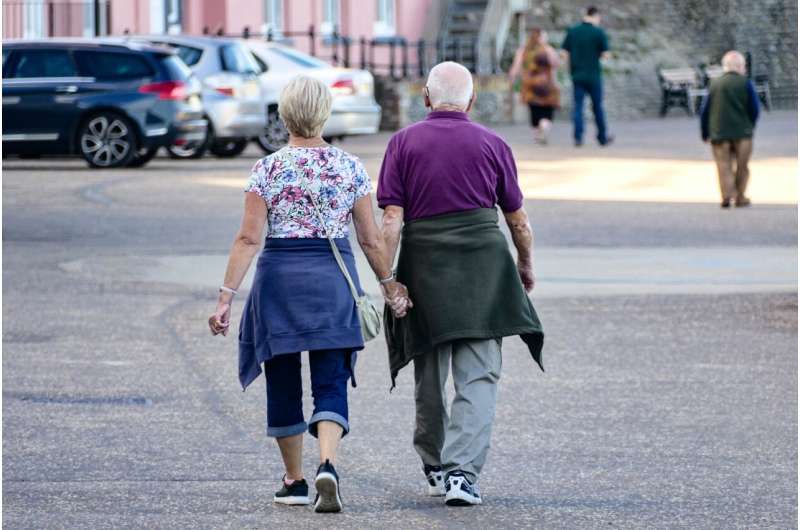This article has been reviewed according to Science X's editorial process and policies. Editors have highlighted the following attributes while ensuring the content's credibility:
fact-checked
peer-reviewed publication
trusted source
proofread
Walking 25 minutes a day is enough to counter physical impact of bed rest on older hospital patients

As little as 25 minutes a day of slow walking seems to be enough to counter the detrimental physical effects of bed rest on older hospital patients, finds a pooled data analysis of the available evidence, published online in the British Journal of Sports Medicine.
For optimal improvements in physical function, around 50 minutes a day of slow walking or around 40 minutes of combined physical activities, such as 20 minutes of resistance bands with around 20 minutes of aerobic activity, are the most effective, the analysis indicates.
But there may be a threshold effect, with no clear benefit for "doses" of more than 90 minutes a day of light intensity, or 60 minutes per day of moderate intensity, physical activity, it finds.
Older people admitted to hospital, even those who can walk unaided by themselves, spend most of their stay in bed. But this level of inactivity can cause "post-hospital syndrome"—-a period of vulnerability after discharge associated with general physical deconditioning. If not actively managed, this may have various consequences, including readmission, disability, the need for nursing home care, illness or death, emphasize the researchers.
Recently published research indicates that getting older hospital patients out of bed and moving about can help ward off physical decline, but it's not clear what type of activity or how much of it might be most effective.
In a bid to find out, the researchers looked for published clinical trials that involved people over the age of 50 who had been admitted to hospital for a serious bout of illness and prescribed any form of physical activity during their inpatient stay.
They included only those trials that involved a comparison group receiving usual care or another type of physical activity; that assessed changes in functional capacity—ability to perform routine activities of daily living, for example—and that recorded any adverse consequences, at discharge or at any subsequent monitoring point.
Nineteen clinical trials out of an initial group of 44, involving 3,842 participants and published between 2000 and 2022, were included.
The final analysis included 3,783 participants, over half of whom (2,087; 55%) were women, ranging in age from 55 to 87. Their average length of stay was 7 days; and the average monitoring period after discharge was 68 days.
Pooling the trial results showed that the minimal dose required to counter the effects of bed rest and improve older inpatients' functional capacity was estimated to be around 40 minutes a day of light intensity physical activity or around 25 minutes a day of moderate intensity physical activity.
And the optimal amount was estimated to be 70 minutes per day of light intensity, or around 40 minutes a day of moderate intensity physical activity.
There was no clear benefit for doses of more than 90 minutes a day of light intensity, or 60 minutes a day of moderate intensity physical activity, suggesting a threshold effect.
In terms of the best type of physical activity to ward off physical decline, a mix of physical activity in any one daily session and slow-paced walking were deemed the most effective.
But only walking was more than 80% effective, with the optimal dose reached at around 50 minutes a day, and the minimal effective dose reached at 25 minutes a day.
The analysis showed that the effectiveness of physical activity interventions increased from admission to discharge, peaking at around 19 days after discharge.
The fall rate, the most common occurrence after discharge, was similar among the intervention and comparison groups, but those prescribed physical activity experienced fewer adverse consequences, overall, than those given usual care.
The researchers acknowledge that there was little information on monitoring frequency after discharge and that only participants who were able to move unaided were included, both of which may weaken the findings and limit their wider applicability.
But they point out, "Older adults are projected to comprise more than 60% of the total hospital inpatient population by 2030. Based on the existing evidence to date, this review has shown the optimal type and dose of physical activity necessary to prevent functional decline and reduce adverse events in older adults admitted to hospital."
And they conclude, "If the most potent intervention is provided [walking], the beneficial effects of in-hospital supervised physical activity programs can be maximized with as little as around 25 minutes/day of slow-paced walking, an achievable target for most hospitalized older adults.
"Together, this meta-analysis has yielded critical information to support the use of physical activity as a core part of the daily routine of acutely hospitalized older adults."
More information: Optimal dose and type of physical activity to improve functional capacity and minimise adverse events in acutely hospitalised older adults: a systematic review with dose-response network meta-analysis of randomised controlled trials, British Journal of Sports Medicine (2023). DOI: 10.1136/bjsports-2023-106409





















